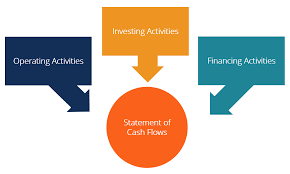How to Understand the Cash Flow Statement
The Cash Flow Statement Shows Sources of Cash and cash equivalents and breaks the analysis down to operating, investing, and financing.
The Statement shows Sources of Cash and cash equivalents and breaks the analysis down to operating, investing, and financing activities. The Financial Accounting and Standards Board (FASB) promulgates the report.
Whether you are an accountant, business owner, entrepreneur, or investor, knowing how to read and understand The Cash Flow Statement can enable you to extract important data about the financial health of a company.
If you are an investor, this information can help you better understand whether you should invest in a company. If you are a business owner or entrepreneur, it can help you understand business performance and adjust key initiatives or strategies. If you are a manager, it can help you more effectively manage budgets, oversee your team, and develop closer relationships with leadership—ultimately allowing you to play a larger role within your organization.
Not everyone has finance or accounting expertise. For non-finance professionals, understanding the concepts behind the Statement and other financial documents can be challenging.
To facilitate this understanding, here is everything you need to know about how to read and understand the statement.
WHAT IS A CASH FLOW STATEMENT?
The purpose of a cash flow statement is to provide a detailed picture of what happened to a business’s cash during a specified period, known as the accounting period. It demonstrates an organization’s ability to operate in the short and long term, based on how much cash is flowing into and out of the business.
The statement is typically broken into three sections:
- Operating activities
- Investing activities
- Financing activities
Operating activities detail cash flow that is generated once the company delivers its regular goods or services and includes both revenue and expenses. Investing activities include cash flow from purchasing or selling assets—think physical property, such as real estate or vehicles, and non-physical property, like patents—using free cash, not debt. Financing activities detail cash flow from both debt and equity financing.
Based on The Statement of Cash Flow, you can see how much cash different types of activities generate, then make business decisions based on your analysis of financial statements.
Ideally, a company’s cash from operating income should routinely exceed its net income because a positive cash flow speaks to a company’s ability to remain solvent and grow its operations.
It is important to note that cash flow is different from profit, which is why a cash flow statement is often interpreted together with other financial documents, such as a balance sheet and income statement.
HOW CASH FLOW STATEMENT IS CALCULATED
Now that you understand what comprises the statement and why it’s important for financial analysis, here’s a look at two common methods used to calculate and prepare the operating activities section of cash flow statements.
Direct Method
The first method used to calculate the operation section is called the direct method, which is based on the transactional information that impacted cash during the period. To calculate the operation section using the direct method, take all cash collections from operating activities, and subtract all of the cash disbursements from the operating activities.
Indirect Method
The second way to prepare the operating section of the statement of cash flows is called the indirect method. This method depends on the accrual accounting method in which the accountant records revenues and expenses at times other than when cash was paid or received—meaning that these accrual entries and adjustments cause the cash flow from operating activities to differ from net income.
Instead of organizing transactional data like the direct method, the CPA starts with the net income number found from the income statement and adjusts undo the impact of the accruals that were made during the period.
Essentially, the accountants will convert net income to actual cash flow by de-accruing it through a process of identifying any non-cash expenses for the period from the income statement. The most common and consistent of these are depreciation, the reduction in the value of an asset over time, and amortization, the spreading of payments over multiple periods.
HOW TO INTERPRET THE CASH FLOW STATEMENT
Whenever you review any financial statement, you should consider it from a business perspective. Financial documents are designed to provide insight into the financial health and status of an organization.
For example, cash flow statements can reveal what phase a business is in: whether it’s a rapidly growing startup or a mature and profitable company. It can also reveal whether a company is going through transition or in a state of decline.
Using this information, an investor might decide that a company with uneven cash flow is too risky to invest in; or they might decide that a company with positive cash flow is primed for growth. Similarly, a department head might look at a cash flow statement to understand how their department is contributing to the health and wellbeing of the company and use that insight to adjust their department’s activities. Cash flow might also impact internal decisions, such as budgeting, or the decision to hire (or fire) employees.
The Cash Flow Statement is typically depicted as being positive (the business is taking in more cash than it’s expending) or negative (the business is spending more cash than it’s receiving).
Positive Cash Flow
Positive cash flow indicates that a company has more money flowing into the business than out of it over a specified period. This is an ideal situation to be in because having an excess of cash allows the company to reinvest in itself and its shareholders, settle debt payments, and find new ways to grow the business.
Positive cash flow does not necessarily translate to profit, however. Your business can be profitable without being cash flow-positive, and you can have positive cash flow without making a profit.
Negative Cash Flow
Having negative cash flow means your cash outflow is higher than your cash inflow during a period, but it does not necessarily mean profit is lost. Instead, negative cash flow may be caused by expenditure and income mismatch, which should be addressed as soon as possible.
Negative cash flow may also be caused by a company’s decision to expand the business and invest in future growth, so it’s important to analyze changes in cash flow from one period to another, which can indicate how a company is performing overall.
THE CASH FLOW STATEMENT EXAMPLE
Here is an example of a cash flow statement generated by a fictional company, which shows the kind of information typically included and how it’s organized.
This statement shows Company A started the year with approximately $10.75 billion in cash and equivalents.
The Cash Flow Statement is broken out into cash flow from operating activities, investing activities, and financing activities. The business brought in $53.66 billion through its regular operating activities. Meanwhile, it spent approximately $33.77 billion in investment activities, and a further $16.3 billion in financing activities, for a total cash outflow of $50.1 billion.
The result is the business ended the year with a positive cash flow of $3.5 billion, and total cash of $14.26 billion.
THE IMPORTANCE OF THE CASH FLOW STATEMENT
The Cash Flow Statement is one of the most critical financial documents that an organization prepares, offering valuable insight into the health of the business. By learning how to read the statement and other financial documents, you can acquire the skills to make smarter business and investment decisions, regardless of your position. International Accounting Standard 7 (IAS 7) is the International Accounting Standard that deals with the statements.
Are you interested in gaining a toolkit for making smart financial decisions and the confidence to communicate those decisions to key internal and external stakeholders? Explore our online courses Financial Accounting and Leading with Finance and discover how you can unlock critical insights into your organization’s performance and potential.
How to Understand the Cash Flow Statement
Welcome to the Gutenberg Editor
The goal of this new editor is to make adding rich content to WordPress simple and enjoyable. This whole post is composed of pieces of content—somewhat similar to LEGO bricks—that you can move around and interact with. Move your cursor around and you’ll notice the different blocks light up with outlines and arrows. Press the
How to Increase Profit Margins Through Virtual CFO Services
How to Increase Profit Margins Through Virtual CFO Services

Great Accounting Firms Share These 10 Traits
Great Accounting Firms Share These 10 Traits which has gone far beyond the paper-pushing days and now involves acting as a virtual CFO

Tax Accountant in Miami Cope with IRS Tax Season Delay
Tax Accountant said IRS delays start of tax season for individual returns would be postponed until February 17 with some as late as March

Miami Accountants Philosophy of Up or Out
Its up or out for Miami Accountants firms are faced with the dilemma of keeping long-term managers that are not ready to be equity partners or let them go.

Contadores en Miami Explican Auditorías del IRS
Contadores en Miami, Gustavo A Viera CPA, explica los pasos de una auditoría, desde la notificación de la auditoría hasta el cierre de la misma
Home » Blog » Accountants in Miami » How to Understand the Cash Flow Statement

